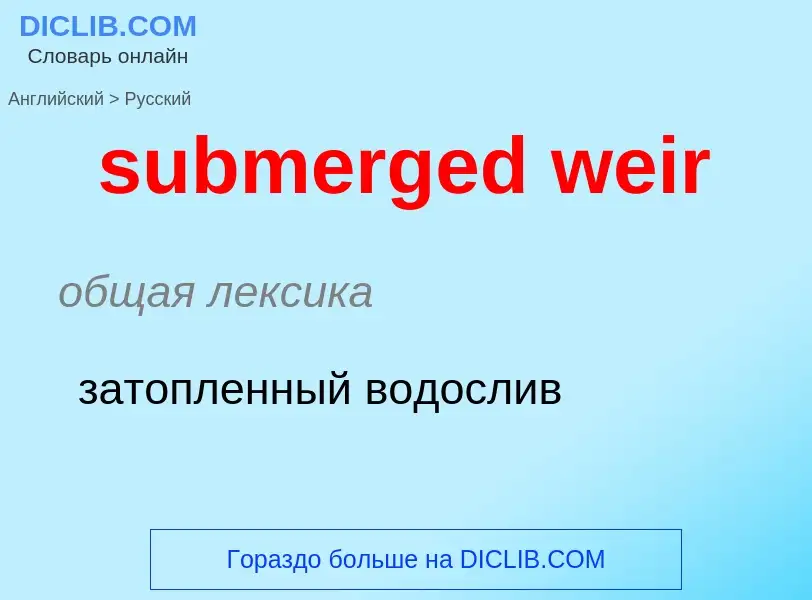Перевод и анализ слов искусственным интеллектом ChatGPT
На этой странице Вы можете получить подробный анализ слова или словосочетания, произведенный с помощью лучшей на сегодняшний день технологии искусственного интеллекта:
- как употребляется слово
- частота употребления
- используется оно чаще в устной или письменной речи
- варианты перевода слова
- примеры употребления (несколько фраз с переводом)
- этимология
submerged weir - перевод на русский
общая лексика
затопленный водослив
['fiʃwiə]
существительное
общая лексика
запруда для ловли или разведения рыбы
['wɪəgru:p]
общая лексика
"Уир груп" (холдинг-компания [holding company], контролирующая группу фирм в строительной и машиностроительной промышленности. Основана в 1886)
полное выражение
The Weir Group
[wiə]
общая лексика
плотина
запруда
сооружать плотину
запруживать
водослив
слив
морской термин
полузапруда
строительное дело
водоподъёмная плотина
водосливная плотина
нефтегазовая промышленность
перегородка (в желобках отстойной системы)
переливная камера
затвор сливного отверстия (на тарелке ректификационной колонны)
Смотрите также
существительное
[wiə]
общая лексика
плотина
запруда
водослив
плотина, запруда
глагол
общая лексика
устраивать плотину
запруживать
устраивать плотину, запруживать
общая лексика
дуговая сварка под флюсом
Определение
Википедия
Submerged arc welding (SAW) is a common arc welding process. The first SAW patent was taken out in 1935. The process requires a continuously fed consumable solid or tubular (metal cored) electrode. The molten weld and the arc zone are protected from atmospheric contamination by being "submerged" under a blanket of granular fusible flux consisting of lime, silica, manganese oxide, calcium fluoride, and other compounds. When molten, the flux becomes conductive, and provides a current path between the electrode and the work. This thick layer of flux completely covers the molten metal thus preventing spatter and sparks as well as suppressing the intense ultraviolet radiation and fumes that are a part of the shielded metal arc welding (SMAW) process.
SAW is normally operated in the automatic or mechanized mode, however, semi-automatic (hand-held) SAW guns with pressurized or gravity flux feed delivery are available. The process is normally limited to the flat or horizontal-fillet welding positions (although horizontal groove position welds have been done with a special arrangement to support the flux). Deposition rates approaching 45 kg/h (100 lb/h) have been reported — this compares to ~5 kg/h (10 lb/h) (max) for shielded metal arc welding. Although currents ranging from 300 to 2000 A are commonly utilized, currents of up to 5000 A have also been used (multiple arcs).
Single or multiple (2 to 5) electrode wire variations of the process exist. SAW strip-cladding utilizes a flat strip electrode (e.g. 60 mm wide x 0.5 mm thick). DC or AC power can be used, and combinations of DC and AC are common on multiple electrode systems. Constant voltage welding power supplies are most commonly used; however, constant current systems in combination with a voltage sensing wire-feeder are available.



![John White]] (1585). John White]] (1585).](https://commons.wikimedia.org/wiki/Special:FilePath/Indians fishing de bry.jpg?width=200)
![Salmon weir at Quamichan Village on the [[Cowichan River]], [[Vancouver Island]], ca 1866 Salmon weir at Quamichan Village on the [[Cowichan River]], [[Vancouver Island]], ca 1866](https://commons.wikimedia.org/wiki/Special:FilePath/Salmon weir at Quamichan Village on the Cowichan River, Vancouver Island.jpg?width=200)

![Remains of an ancient stone fishing weir in the tidal [[Menai Strait]] in Wales Remains of an ancient stone fishing weir in the tidal [[Menai Strait]] in Wales](https://commons.wikimedia.org/wiki/Special:FilePath/Fish trap Menai Strait.jpg?width=200)
![[[Double Heart]] fishing weir in [[Penghu]], Taiwan [[Double Heart]] fishing weir in [[Penghu]], Taiwan](https://commons.wikimedia.org/wiki/Special:FilePath/Double-Heart of Stacked Stones 20150721.jpg?width=200)
![Fishing weir, [[Penghu]] County Fishing weir, [[Penghu]] County](https://commons.wikimedia.org/wiki/Special:FilePath/澎湖石滬 1.jpg?width=200)
![Fishing weir on the rapidly flowing [[Mogami River]] in Japan Fishing weir on the rapidly flowing [[Mogami River]] in Japan](https://commons.wikimedia.org/wiki/Special:FilePath/Yana.jpg?width=200)
![Fishing weirs using baskets at a river waterfall, [[Democratic Republic of the Congo]] Fishing weirs using baskets at a river waterfall, [[Democratic Republic of the Congo]]](https://commons.wikimedia.org/wiki/Special:FilePath/Fishing at the falls Dem Rep Congo.jpg?width=200)
![Ancient V-shaped fishing weir at Countisbury Cove, [[Somerset]] Ancient V-shaped fishing weir at Countisbury Cove, [[Somerset]]](https://commons.wikimedia.org/wiki/Special:FilePath/Ancient Fishing Weir - geograph.org.uk - 637068.jpg?width=200)
![anchovy]] weir in the [[Oosterschelde]] near [[Bergen op Zoom]] in the Netherlands (aerial view) anchovy]] weir in the [[Oosterschelde]] near [[Bergen op Zoom]] in the Netherlands (aerial view)](https://commons.wikimedia.org/wiki/Special:FilePath/Weervisserij Oosterschelde.jpg?width=200)

.jpg?width=200)


![A broadcrest weir at the Thorp grist mill in [[Thorp, Washington]], USA A broadcrest weir at the Thorp grist mill in [[Thorp, Washington]], USA](https://commons.wikimedia.org/wiki/Special:FilePath/Thorp Gristmill Weir.jpg?width=200)
![A weir on the Tikkurilankoski rapids in [[Vantaa]], [[Finland]] A weir on the Tikkurilankoski rapids in [[Vantaa]], [[Finland]]](https://commons.wikimedia.org/wiki/Special:FilePath/Tikkurilankoski in April.jpg?width=200)
![2018 winter cold wave.]] 2018 winter cold wave.]]](https://commons.wikimedia.org/wiki/Special:FilePath/Weir at Bray Lock, May 2018.jpg?width=200)
![River Stour]], [[Dorset]], UK River Stour]], [[Dorset]], UK](https://commons.wikimedia.org/wiki/Special:FilePath/Dorset sn weir 01.jpg?width=200)
![Durham]], UK: the lower weir is a compound weir that also has [[fish ladders]] to allow fish such as salmon to navigate the weir Durham]], UK: the lower weir is a compound weir that also has [[fish ladders]] to allow fish such as salmon to navigate the weir](https://commons.wikimedia.org/wiki/Special:FilePath/Weir on the river wear.png?width=200)
![River Meuse]], [[France]] River Meuse]], [[France]]](https://commons.wikimedia.org/wiki/Special:FilePath/Revin Meuse weir 20041230- 024.jpg?width=200)
![Warkworth]], New Zealand Warkworth]], New Zealand](https://commons.wikimedia.org/wiki/Special:FilePath/WarkworthweirSeuilNewZealand.jpg?width=200)
![A complicated series of broad-crest and V-notch weirs at [[Dobbs Weir]] in [[Hertfordshire]], UK A complicated series of broad-crest and V-notch weirs at [[Dobbs Weir]] in [[Hertfordshire]], UK](https://commons.wikimedia.org/wiki/Special:FilePath/Dobbsweirvdropsjan2006.jpg?width=200)
